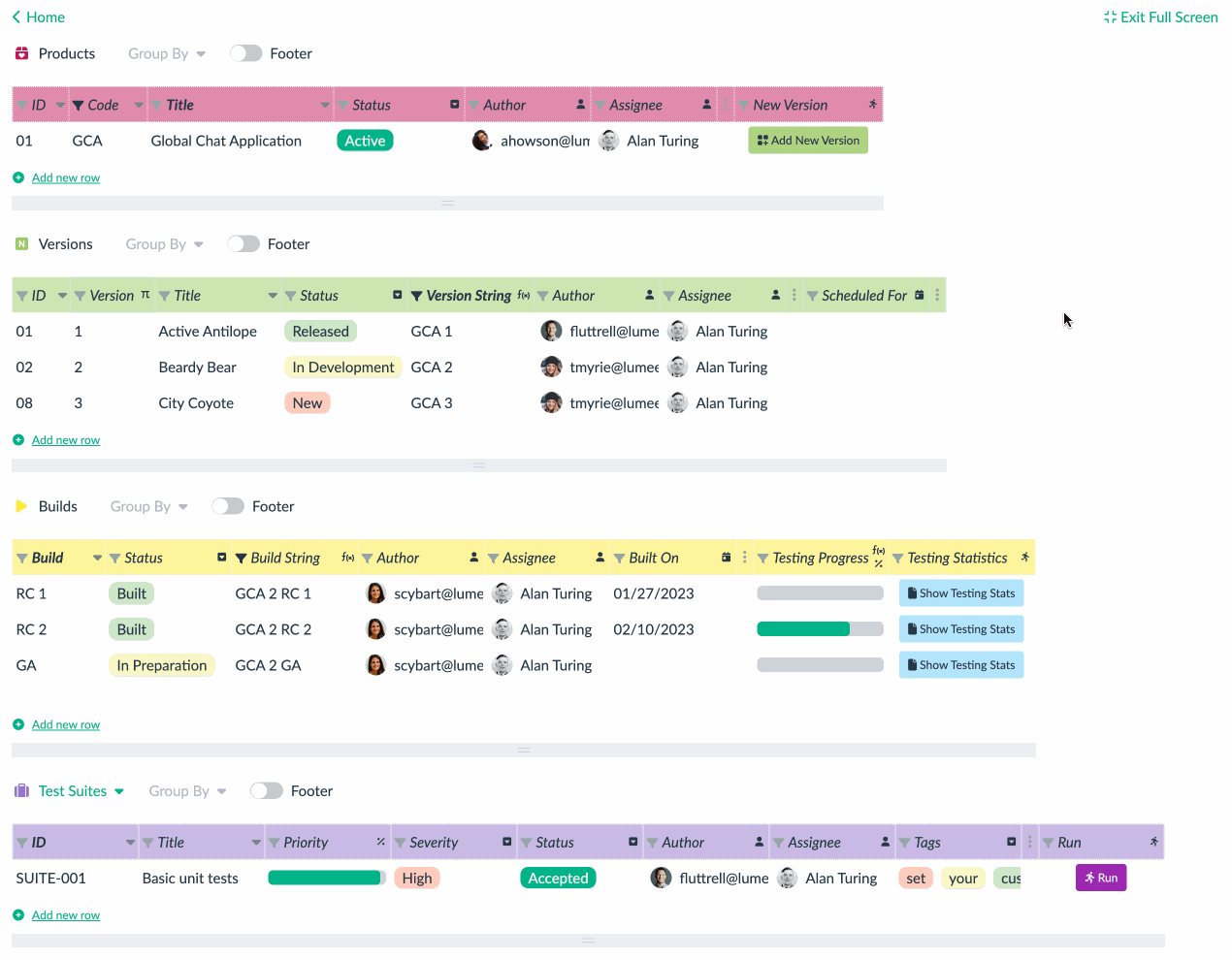Test Case Management System

Streamline your testing process and deliver high-quality products with ease.
A Test Case Management System (TCMS) is a critical tool for testing teams, enabling them to efficiently organize, track, and execute test cases.
And by testing teams, we mean not just software testing teams. Testing is nowadays common in many other industries as well.
As industries continue to grow in complexity, managing test cases manually or through spreadsheets can quickly become a nightmare. However, with a TCMS in place, testing teams can streamline their testing process and deliver high-quality products faster.
If you are interested in (not only) software testing and all its aspect, check the Ministry of Testing.
In this article, we’ll explore the critical aspects of TCMS, demonstrate an ideal workflow, and show you how the TCMS template in Lumeer improves your testing process.
Remember that many of these aspects are now being adopted by industries other than just software development. Especially in industries that adopt agile practices like various manufacturers (e.g., automotive, pharmaceuticals).
Key Aspects of Test Case Management System
A Test Case Management System (TCMS) template in Lumeer is a comprehensive tool that simplifies the entire test case management process.
It enables your testing teams to store, organize, and track their test cases in a centralized location. It also allows them to streamline their testing process and execute tests effectively.
Following are some key aspects of a TCMS.
Centralized Test Case Storage
One of the most important aspects of a TCMS is its ability to store all test cases in a centralized location.
This eliminates the need to manage test cases using spreadsheets or documents, which can be error-prone and difficult to manage.
A TCMS allows your testing teams to easily add, edit, or delete test cases as needed.
Traceability of Test Cases to Requirements
A TCMS enables your teams to trace test cases to requirements, ensuring that all test cases have a defined objective and that they are aligned with the overall project goals.
This makes it easier to identify which test cases are necessary to validate the product.
Requirements are bound to product versions and products so that you can easily plan new features according to your roadmap.
Test Case Prioritization and Execution Scheduling
Prioritizing test cases is an essential aspect of testing.
A TCMS helps your teams to prioritize test cases based on their importance and execute them accordingly. Moreover, it also helps them to schedule test execution based on project timelines and resource availability.
Test Cases are part of test suites which are bound to product versions.
Collaboration and Communication Among Team Members
Effective collaboration and communication are key aspects of testing.
A TCMS enables your teams to collaborate, share their knowledge and expertise, and communicate effectively about test cases, defects, and testing progress.
This ensures that all team members are on the same page and that the testing process runs smoothly.
Reporting and Analysis of Test Results
Test suites are planned for execution on specific product versions. Every test run is executed on a specific environment. Create any environment attributes that match your needs.
Lumeer’s Test Case Management System allows your testing teams to generate reports that provide insight into testing progress and results.
This helps to identify defects early in the testing process, reducing the overall cost of fixing defects.
Your teams can also analyze test results to identify trends and patterns, improving the testing process.
Ideal Workflow in a Test Case Management System
By following an ideal workflow in a TCMS, your testing teams can streamline their testing process and deliver high-quality products on time and within budget.
An ideal workflow should include test case creation, organization, prioritization, execution, defect management, and reporting and analysis.

Here’s what an ideal workflow in a TCMS should look like.
1. Products, Versions, Builds, Environments…
First, it is important to define the entities that you will work with. These are:
- Products that will be tested,
- Versions of the products that are released and planned for a release,
- Builds of product versions that will be tested,
- Environments that describe conditions under which the builds are tested.

2. Test Case Creation
The next step in an ideal TCMS workflow is to create test cases. Test cases should be created based on the project requirements, and each test case should have a defined objective and expected outcome.

3. Test Case Organization
Once you have created the test cases, they should be organized logically and structured. This includes grouping test cases by test types, features, or modules.

4. Test Case Prioritization
Prioritize test cases based on their importance and potential impact. This ensures that critical test cases are executed first, reducing the risk of undetected defects.

5. Test Case Execution
Once test cases have been prioritized, they can be executed in the TCMS. Testers should ensure that all test cases are executed according to their priority and that any defects are documented in the TCMS.

6. Defect Management
Defects should be managed in the TCMS as well. This allows your teams to track and prioritize defects for resolution. Each defect should be associated with the test case that uncovered it, providing traceability to the requirements.

7. Reporting and Analysis
Finally, the TCMS generates reports and analyzes testing progress and results. This helps identify defects early in the testing process, reducing the overall cost of fixing defects.


Resolved defects can be also added to the defects reported chart for comparison and trends observation.
Summary of Test Case Management
In summary, a Test Case Management System provides numerous benefits to testing teams, including centralized test case storage, traceability of test cases to requirements, test case prioritization and execution scheduling, collaboration and communication among team members, and reporting and analysis of test results.
By leveraging these key aspects of a TCMS, testing teams can improve their testing process and deliver high-quality products on time and within budget.
Try the Template
Try the template right here1).
1) Some of the functions are available only after registration.
Test Case Management System Integrations
Due to Zapier integrations, you can connect your test case management system with the tools you already use, like Google Forms, Jira or Slack.
The detail can be displayed in a Slack message upon a test mention. Or you can have a form for defects reporting. Or automated Jira ticket creation to assign test execution to a team member.
Customizations
Remember that flexibility and customizations are the key benefits of Lumeer.
Lumeer is a flexible platform for building systems that perfectly match your needs. No coding is required.
We will accommodate everything according to your specific needs and workflows. Automations will then carry out all repetitive and mundane tasks for you.
Try the template out and get in touch with us.
Best suited for
Company size: freelancer, startup, small, medium, individual teams in large companies and enterprises
Team size: 2-50
Project complexity: products, versions, environments, builds, requirements, test cases, test suites, test runs, defects
Industry: any where proudcts are tested
